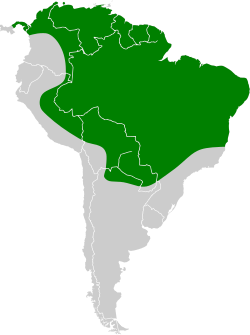| Common name | Scientific name and subspecies | Range | Size and ecology | IUCN status and estimated population |
|---|
| Angolan free-tailed bat  | M. condylurus
Smith, 1833 | Sub-Saharan Africa | Size: 6–8 cm (2–3 in), plus 3–6 cm (1–2 in) tail
4–6 cm (2 in) forearm length [49]
Habitat: Savanna [50] | LC
Unknown  [50] [50]
|
|---|
| Ansorge's free-tailed bat  | M. ansorgei
(Thomas, 1913) | Sub-Saharan Africa | Size: 6–9 cm (2–4 in), plus 3–5 cm (1–2 in) tail
4–6 cm (2 in) forearm length [19]
Habitat: Forest, savanna, and rocky areas [51] | LC
Unknown  [51] [51]
|
|---|
| Black and red free-tailed bat
| M. jobimena
Goodman & Cardiff, 2004 | Western Madagascar
 | Size: 7–8 cm (3 in), plus 3–6 cm (1–2 in) tail
4–5 cm (2 in) forearm length [49]
Habitat: Caves and forest [52] | LC
Unknown  [52] [52]
|
|---|
| Chapin's free-tailed bat  | M. chapini
Allen, 1917 | Central and western Africa | Size: 5–6 cm (2 in), plus 2–5 cm (1–2 in) tail
3–4 cm (1–2 in) forearm length [49]
Habitat: Savanna [53] | LC
Unknown  [53] [53]
|
|---|
| Duke of Abruzzi's free-tailed bat
| M. aloysiisabaudiae
(Festa, 1907) | Central and western Africa | Size: 7–9 cm (3–4 in), plus 3–5 cm (1–2 in) tail
4–6 cm (2 in) forearm length [19]
Habitat: Savanna and forest [54] | LC
Unknown  [54] [54]
|
|---|
| Dwarf free-tailed bat
| M. nanulus
Allen, 1917 | Central and western Africa | Size: 5–6 cm (2 in), plus 1–3 cm (0–1 in) tail
2–4 cm (1–2 in) forearm length [49]
Habitat: Forest [55] | LC
Unknown  [55] [55]
|
|---|
| Fijian mastiff bat
| M. bregullae
(Felten, 1964) | Fiji and Vanuatu
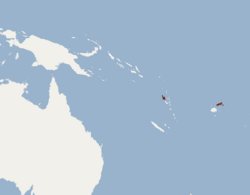 | Size: 6–7 cm (2–3 in), plus 4–5 cm (2 in) tail
5–6 cm (2 in) forearm length [49]
Habitat: Forest and caves [56] | EN
5,000–7,000  [56] [56]
|
|---|
| Gallagher's free-tailed bat
| M. gallagheri
(Harrison, 1975) | Democratic Republic of the Congo
 | Size: About 5 cm (2 in), plus about 3 cm (1 in) tail
About 4 cm (2 in) forearm length [49]
Habitat: Forest [57] | DD
Unknown  [57] [57]
|
|---|
| Gland-tailed free-tailed bat
| M. bemmeleni
(Jentink, 1879)
- M. b. bemmeleni
- M. b. cistura
| Central and western Africa | Size: 6–7 cm (2–3 in), plus 3–4 cm (1–2 in) tail
4–5 cm (2 in) forearm length [19]
Habitat: Forest and savanna [58] | LC
Unknown  [58] [58]
|
|---|
| Grandidier's free-tailed bat
| M. leucogaster
(Grandidier, 1869) | Madagascar | Size: 5–7 cm (2–3 in), plus 2–4 cm (1–2 in) tail
3–4 cm (1–2 in) forearm length [49]
Habitat: Forest and savanna [59] | LC
Unknown  [59] [59]
|
|---|
| Lappet-eared free-tailed bat
| M. major
(Trouessart, 1897) | Eastern and western Africa | Size: 5–8 cm (2–3 in), plus 2–5 cm (1–2 in) tail
3–5 cm (1–2 in) forearm length [49]
Habitat: Savanna and rocky areas [60] | LC
Unknown  [60] [60]
|
|---|
| Little free-tailed bat  | M. pumilus
(Cretzschmar, 1826) | Sub-Saharan Africa | Size: 4–7 cm (2–3 in), plus 2–4 cm (1–2 in) tail
3–5 cm (1–2 in) forearm length [49]
Habitat: Forest, savanna, and shrubland [61] | LC
Unknown  [61] [61]
|
|---|
| Madagascar free-tailed bat
| M. atsinanana
Goodman, Buccas, Naidoo, Ratrimomanarivo, Taylor, & Lamb, 2010 | Eastern Madagascar | Size: 6–7 cm (2–3 in), plus 2–4 cm (1–2 in) tail
3–5 cm (1–2 in) forearm length [49]
Habitat: Forest [62] | LC
Unknown  [62] [62]
|
|---|
| Malagasy white-bellied free-tailed bat
| M. leucostigma
Allen, 1918 | Madagascar
 | Size: 7–9 cm (3–4 in), plus 3–5 cm (1–2 in) tail
4–5 cm (2 in) forearm length [6]
Habitat: Forest and caves [63] | LC
Unknown  [63] [63]
|
|---|
| Malayan free-tailed bat
| M. mops
(Blainville, 1840) | Indonesia and Malaysia
 | Size: 6–8 cm (2–3 in), plus 3–4 cm (1–2 in) tail
4–5 cm (2 in) forearm length [6]
Habitat: Forest [64] | NT
Unknown  [64] [64]
|
|---|
| Medje free-tailed bat
| M. congicus
Allen, 1917 | Central Africa | Size: 9–10 cm (4 in), plus 3–6 cm (1–2 in) tail
5–6 cm (2 in) forearm length [49]
Habitat: Forest [65] | LC
Unknown  [65] [65]
|
|---|
| Midas free-tailed bat  | M. midas
(Sundevall, 1843) | Scattered Africa | Size: 8–10 cm (3–4 in), plus 3–6 cm (1–2 in) tail
5–7 cm (2–3 in) forearm length [49]
Habitat: Forest, savanna, and desert [66] | LC
Unknown  [66] [66]
|
|---|
| Mongalla free-tailed bat  | M. demonstrator
Thomas, 1903 | Western and central Africa | Size: 7–9 cm (3–4 in), plus 2–4 cm (1–2 in) tail
4–5 cm (2 in) forearm length [49]
Habitat: Savanna [67] | LC
Unknown  [67] [67]
|
|---|
| Niangara free-tailed bat
| M. niangarae
Allen, 1917 | Central Africa | Size: About 9 cm (4 in), plus about 3 cm (1 in) tail
About 5 cm (2 in) forearm length [49]
Habitat: Unknown [68] | DD
Unknown  [68] [68]
|
|---|
| Nigerian free-tailed bat  | M. nigeriae
Thomas, 1913
- M. n. nigeriae
- M. n. spillmani
| Sub-Saharan Africa | Size: 6–8 cm (2–3 in), plus 3–6 cm (1–2 in) tail
4–6 cm (2 in) forearm length [49]
Habitat: Savanna and forest [69] | LC
Unknown  [69] [69]
|
|---|
| Northern freetail bat
| M. jobensis
(Miller, 1902)
- M. j. colonicus
- M. j. jobensis
| Northern Australia and southeastern Asia | Size: 5–9 cm (2–4 in), plus 3–5 cm (1–2 in) tail
4–6 cm (2 in) forearm length [49]
Habitat: Forest, savanna, shrubland, and caves [70] | LC
Unknown  [70] [70]
|
|---|
| Northern free-tailed bat 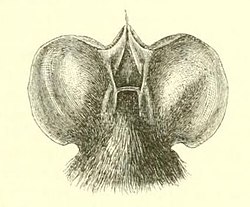 | M. johorensis
(Dobson, 1873) | Indonesia and Malaysia
 | Size: 6–8 cm (2–3 in), plus 3–5 cm (1–2 in) tail
4–5 cm (2 in) forearm length [49]
Habitat: Forest [71] | VU
Unknown  [71] [71]
|
|---|
| Peterson's free-tailed bat
| M. petersoni
El-Rayah, 1981 | Western Africa | Size: About 7 cm (3 in), plus about 3 cm (1 in) tail
3–4 cm (1–2 in) forearm length [49]
Habitat: Forest [72] | NT
Unknown  [72] [72]
|
|---|
| Railer bat  | M. thersites
(Thomas, 1903) | Western and central Africa | Size: 6–7 cm (2–3 in), plus 2–4 cm (1–2 in) tail
3–5 cm (1–2 in) forearm length [6]
Habitat: Forest [73] | LC
Unknown  [73] [73]
|
|---|
| Russet free-tailed bat
| M. russatus
Allen, 1917 | Western and central Africa | Size: 6–8 cm (2–3 in), plus 2–4 cm (1–2 in) tail
4–5 cm (2 in) forearm length [49]
Habitat: Forest and savanna [74] | DD
Unknown  [74] [74]
|
|---|
| São Tomé free-tailed bat
| M. tomensis
(Juste & Ibáñez, 1993) | São Tomé and Príncipe
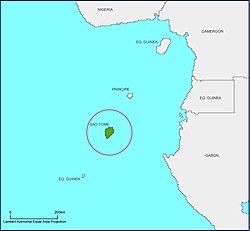 | Size: 5–6 cm (2 in), plus 2–4 cm (1–2 in) tail
3–4 cm (1–2 in) forearm length [49]
Habitat: Forest and savanna [75] | EN
Unknown  [75] [75]
|
|---|
| Seychelles free-tailed bat
| M. pusillus
Miller, 1902 | Comoro Islands and Seychelles | Size: 5–6 cm (2 in), plus 2–4 cm (1–2 in) tail
3–4 cm (1–2 in) forearm length [49]
Habitat: Forest [76] | VU
Unknown  [76] [76]
|
|---|
| Shortridge's free-tailed bat
| M. shortridgei
Thomas, 1926 | South-central Africa | Size: 5–6 cm (2 in), plus 2–5 cm (1–2 in) tail
3–4 cm (1–2 in) forearm length [49]
Habitat: Savanna | NE
Unknown 
|
|---|
| Sierra Leone free-tailed bat 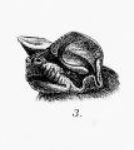 | M. brachypterus
(Peters, 1852)
- M. b. brachypterus
- M. b. leonis
| Western, central, and eastern Africa | Size: 5–7 cm (2–3 in), plus 2–4 cm (1–2 in) tail
3–5 cm (1–2 in) forearm length [49]
Habitat: Forest [77] | LC
Unknown  [77] [77]
|
|---|
| Solomons mastiff bat
| M. solomonis
Troughton, 1931 | Solomon Islands | Size: 5–7 cm (2–3 in), plus 3–4 cm (1–2 in) tail
4–5 cm (2 in) forearm length [49]
Habitat: Forest, caves, and coastal marine [78] | EN
Unknown  [78] [78]
|
|---|
| Spotted free-tailed bat  | M. bivittatus
(Heuglin, 1861) | Eastern Africa | Size: 7–9 cm (3–4 in), plus 3–5 cm (1–2 in) tail
4–6 cm (2 in) forearm length [49]
Habitat: Savanna, rocky areas, and caves [79] | LC
Unknown  [79] [79]
|
|---|
| Spurrell's free-tailed bat
| M. spurrelli
Dollman, 1911 | Western and central Africa | Size: 5–7 cm (2–3 in), plus 2–3 cm (1 in) tail
2–3 cm (1 in) forearm length [6]
Habitat: Forest [80] | LC
Unknown  [80] [80]
|
|---|
| Sulawesi free-tailed bat
| M. sarasinorum
(von Meyer, 1899)
- M. s. lanei
- M. s. sarasinorum
| Indonesia and the Philippines
 | Size: 6–8 cm (2–3 in), plus 3–4 cm (1–2 in) tail
3–5 cm (1–2 in) forearm length [6]
Habitat: Forest [81] | DD
Unknown  [81] [81]
|
|---|
| Trevor's free-tailed bat 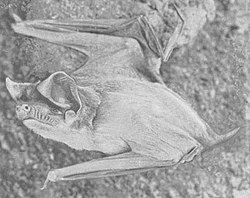 | M. trevori
Allen, 1917 | Western and central Africa | Size: 8–9 cm (3–4 in), plus 3–5 cm (1–2 in) tail
5–6 cm (2 in) forearm length [6]
Habitat: Forest and savanna [82] | DD
Unknown  [82] [82]
|
|---|
| White-bellied free-tailed bat
| M. niveiventer
Cabrera & Ruxton, 1926 | Central Africa | Size: 7–8 cm (3 in), plus 3–4 cm (1–2 in) tail
4–5 cm (2 in) forearm length [49]
Habitat: Forest and savanna [83] | LC
Unknown  [83] [83]
|
|---|
| Wrinkle-lipped free-tailed bat 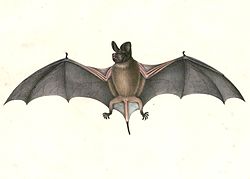 | M. plicatus
Buchanan, 1880 | Eastern and southeastern Asia
 | Size: 6–8 cm (2–3 in), plus 2–4 cm (1–2 in) tail
4–5 cm (2 in) forearm length [49]
Habitat: Forest and caves [84] | LC
Unknown  [84] [84]
|
|---|











